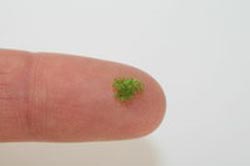Moss beats Human – Simple moss plants outperform us by gene number

Tiny moss has more genes than humans have<br>© Plant Biotechnology, University of Freiburg, Germany
This is about 10,000 genes more than the human genome contains. Mosses are tiny plants with a simple body plan: They have no roots, no flowers and do not produce seeds. Therefore, they were for a long time they were considered to be simple organisms also at the genetic level.
The moss Physcomitrella was chosen by Reski early on as the organism of choice and is now well established as a model species for basic biology, biotechnology, and synthetic biology on a worldwide scale. Consequently, the US Department of Energy Joint Genome Institute (US DoE JGI) has ennobled the Physcomitrella genome as a “flagship genome”. The experts believe that flagship genomes contain information that will help us cope with major challenges occurring during global climate change. The expectations include improved crop yields, disease and insect resistance, drought tolerance, and more efficient biofuel production.
For their recent study the scientists collected all available information on the moss genome as well as transcript evidence and used this data for a completely new bioinformatic analysis. The result is freely available on the community resource www.cosmoss.org, developed and maintained by the Chair of Plant Biotechnology in Freiburg. By combining all DNA and RNA data, the scientists were not only able to annotate the 32,275 genes that encode proteins but also to reveal the so-called “dark matter of the genome”, i.e. those genomic regions that are transcribed into small non-coding RNAs like microRNAs.
“One of our intriguing findings is that 13 per cent of the Physcomitrella genes have no clear relatives in any other sequenced organism so far. Analysing these orphan genes more deeply will reveal the hidden treasures of the moss genome”, Reski says. “Although it seems annoying that mosses outperform humans greatly by gene number, it is exactly this feature that may secure our future.”
Ralf Reski heads the Freiburg Chair of Plant Biotechnology. The biologist is a member of the Cluster of Excellence BIOSS – Centre for Biological Signalling Studies and Senior Fellow at FRIAS, the Freiburg Institute for Advanced Studies of the University of Freiburg. In addition, Reski is co-founder of the Trinational Institute for Plant Research TIP, and, effective from October on, Senior Fellow at USIAS, the University of Strasbourg Institute for Advanced Study, France.
The original publication is:
Andreas Zimmer, Daniel Lang et al. (2013): Reannotation and extended community resources of the non-seed plant Physcomitrella patens provide insights into the evolution of plant gene structures and functions. BMC Genomics 14, 498. It can be viewed as open access publication under http://www.biomedcentral.com/1471-2164/14/498/abstract
Contact:
Prof. Dr. Ralf Reski
Chair Plant Biotechnology
Faculty of Biology
Albert-Ludwigs-University Freiburg, Germany
Tel.: +49-761-203-6969
E-Mail: pbt@biologie.uni-freiburg.de
Media Contact
All latest news from the category: Life Sciences and Chemistry
Articles and reports from the Life Sciences and chemistry area deal with applied and basic research into modern biology, chemistry and human medicine.
Valuable information can be found on a range of life sciences fields including bacteriology, biochemistry, bionics, bioinformatics, biophysics, biotechnology, genetics, geobotany, human biology, marine biology, microbiology, molecular biology, cellular biology, zoology, bioinorganic chemistry, microchemistry and environmental chemistry.
Newest articles

Sea slugs inspire highly stretchable biomedical sensor
USC Viterbi School of Engineering researcher Hangbo Zhao presents findings on highly stretchable and customizable microneedles for application in fields including neuroscience, tissue engineering, and wearable bioelectronics. The revolution in…

Twisting and binding matter waves with photons in a cavity
Precisely measuring the energy states of individual atoms has been a historical challenge for physicists due to atomic recoil. When an atom interacts with a photon, the atom “recoils” in…

Nanotubes, nanoparticles, and antibodies detect tiny amounts of fentanyl
New sensor is six orders of magnitude more sensitive than the next best thing. A research team at Pitt led by Alexander Star, a chemistry professor in the Kenneth P. Dietrich…





















